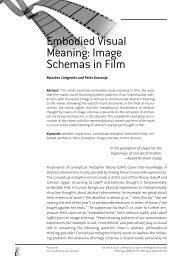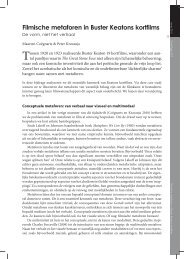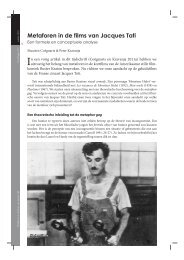A STABILIZED SUPERFAST SOLVER FOR ... - SIAM Journals
A STABILIZED SUPERFAST SOLVER FOR ... - SIAM Journals
A STABILIZED SUPERFAST SOLVER FOR ... - SIAM Journals
Create successful ePaper yourself
Turn your PDF publications into a flip-book with our unique Google optimized e-Paper software.
496 MARC VAN BAREL, GEORG HEINIG, AND PETER KRAVANJA“difficult” points are sorted out and are treated at the end. Also, iterative refinementis applied to stabilize the algorithm. In this way a stabilized generically superfastsolver for indefinite Hankel systems was obtained, i.e., superfast in case the numberof difficult points is small, and fast otherwise.In this paper we use a similar approach for Toeplitz systems. In contrast with [52],the Toeplitz is not first transformed into another matrix, but an explicit formula forthe inverse of a Toeplitz matrix is used. This formula involves the values of the “fundamentalsystem” at roots of unity, i.e., the DFT of the fundamental system. It willbe presented in section 2. The fundamental system is a pair of polynomials containingall the information about the Toeplitz matrix. These polynomials are related to twolinearized rational interpolation problems at roots of unity. This connection will beexplained in section 3. To solve these interpolation problems, we extend the superfastalgorithm presented in [52]. We will incorporate “downdating” into this algorithm asan additional stabilizing technique. In section 5 we will present numerical examplesand compare our results with those obtained in [52]. Note that in [52] the size of theHankel system is limited to a power of 2, whereas we can handle Toeplitz systems ofarbitrary size.2. DFT representation of Toeplitz matrix inverses. Let us introduce thefollowing notation. To each column vector u =[u k ] n k=0 ∈ Cn+1 we associate thepolynomial u(z) : = ∑ nk=0 u kz k ∈ C[z]. The column vector û is defined as û :=[u n−k ] n k=0 . Thus, û(z) =zn u(z −1 ).Let a −n ∈ C be arbitrary and let ˜T = ˜T n be given by the n × (n + 1) matrix˜T :=[a k−l ] n−1,nk,l=0⎡= ⎢⎣⎤a 0 a −1 ··· a −n+1 a −n ⎡.a 1 a .. 0 a−n+1.. .. . ... ⎥ .. ⎦ = ⎢⎣a n−1 ··· ··· a 0 a −1Ta −n.a −1The polynomials u(z) and v(z) are called the canonical fundamental system of T if• ˜Tu = e 1 and u n = 0, where e 1 :=[ 1 0 ··· 0 ] T ,• ˜Tv = 0 and v n =1.In other words, u(z) is a polynomial of degree n − 1 at most while v(z) is a monicpolynomial of degree n such that⎡⎤a 0 a −1 ··· a⎡ ⎤ ⎡ ⎤−n+1 u 0 1. a 1 a .. . 0 u 1⎢⎣. ⎥ ⎢ ⎥. .. a−1 ⎦ ⎣ . ⎦ = 0⎢ ⎥⎣ . ⎦a n−1 ··· ··· a 0u n−1 0⎤⎥⎦ .and⎡⎢⎣⎤a 0 a −1 ··· a⎡−n+1.a 1 a .. 0 .. ⎥ ⎢. .. a−1 ⎦ ⎣a n−1 ··· ··· a 0v 0v 1.v n−1⎤ ⎡⎥⎦ = − ⎢⎣a −na −n+1.a −1⎤⎥⎦ .As T is assumed to be nonsingular, these polynomials do exist. Moreover, u(z) isunique whereas v(z) is uniquely determined given a particular value of a −n . For our
<strong>STABILIZED</strong> <strong>SUPERFAST</strong> <strong>SOLVER</strong> <strong>FOR</strong> TOEPLITZ SYSTEMS 499for k =0, 1,...,2N − 1. Definer(z) :=r − (z)+z 2N−n r + (1/z).Then r(z) is a polynomial of degree ≤ 2N − n and r 0 = δ. Thusfor k =0, 1,...,2N − 1. In other words,a(ω k )w(ω k )=r(ω −1k )= ωk n [ω 2N−nkr(ω −1k )]= ωk n ˆr(ω k )ω n k ˆr(ω k ) − a(ω k )w(ω k )=0, k =0, 1,...,2N − 1,where deg ˆr(z) ≤ 2N − n, ˆr 2N−n = δ, and deg w(z) ≤ n.These interpolation conditions can also be written as follows:[ ωnk−a(ω k ) ] B ⋆ (ω k )= [ 0 0 ] , k =0, 1,...,2N − 1,where[B ⋆ ˆru (z) ˆr(z) :=v (z)u(z) v(z)]∈ C[z] 2×2isa2× 2 matrix polynomial. The degree of the first row of B ⋆ (z) is equal to 2N − nwhereas the degree of the second row of B ⋆ (z) is equal to n. The second row of B ⋆ (z)gives us the inversion parameters that are needed in formula (2.2).4. A stabilized divide and conquer approach. Define[f k :=ω n k−a(ω k )]∈ C 2×1for k =0, 1,...,2N − 1 and let S be the set of all the column vector polynomialsw(z) ∈ C[z] 2×1 that satisfy the interpolation conditions(4.1)f T k w(ω k )=0, k =0, 1,...,2N − 1.If w(z) ∈ C[z] 2×1 is an arbitrary vector polynomial, then the left-hand side of (4.1)is called the residual with respect to w(z) at the interpolation point ω k .The set S forms a submodule of the C[z]-module C[z] 2×1 . A basis for S alwaysconsists of exactly two elements [49, Theorem 3.1]. Let {B 1 (z),B 2 (z)} be a basisfor S. Then every element w(z) ∈Scan be written in a unique way as w(z) =α 1 (z)B 1 (z) +α 2 (z)B 2 (z) with α 1 (z),α 2 (z) ∈ C[z]. The matrix polynomial B(z) :=[ B 1 (z) B 2 (z)]∈ C[z] 2×2 is called a basis matrix. Basis matrices can be characterizedas follows.Theorem 4.1. Amatrix polynomial C(z) =[C 1 (z) C 2 (z)] ∈ C[z] 2×2 is a basismatrix if and only if C 1 (z),C 2 (z) ∈S and deg det C(z) =2N.Proof. The proof follows immediately from [49, Theorem 4.1].Note that B ⋆ (z) is a basis matrix.Within the submodule S we want to be able to consider solutions w(z) that satisfyadditional conditions concerning their degree-structure. To describe the degreestructureof a vector polynomial, we use the concept of τ-degree [49]. Let τ ∈ Z.
500 MARC VAN BAREL, GEORG HEINIG, AND PETER KRAVANJAThe τ-degree of a vector polynomial w(z) =[w 1 (z) w 2 (z)] T ∈ C[z] 2×1 is defined as ageneralization of the classical degree:τ-deg w(z) := max{ deg w 1 (z), deg w 2 (z) − τ }with τ-deg 0 := −∞. The τ-highest degree coefficient of a vector polynomial[ w 1 (z) w 2 (z)] Twith τ-degree δ is defined as the vector [ ω 1 ω 2 ] T with ω 1 the coefficient of z δ in w 1 (z)and ω 2 the coefficient of z δ+τ in w 2 (z). A set of vector polynomials in C[z] 2×1 iscalled τ-reduced if the τ-highest degree coefficients are linearly independent. Everybasis of S can be transformed into a τ-reduced one. For details, we refer to [49]. Oncewe have a basis in τ-reduced form, the elements of S can be parametrized as follows.Theorem 4.2. Let { B 1 (z),B 2 (z) } be a τ-reduced basis for S. Define δ 1 := τ-deg B 1 (z) and δ 2 := τ-deg B 2 (z). Then every element w(z) ∈S having τ-degree ≤ δcan be written in a unique way asw(z) =α 1 (z)B 1 (z)+α 2 (z)B 2 (z)with α 1 (z),α 2 (z) ∈ C[z], deg α 1 (z) ≤ δ − δ 1 , and deg α 2 (z) ≤ δ − δ 2 .Proof. For the proof, see Van Barel and Bultheel [49, Theorem 3.2].We can now summarize our aim as follows:we want to design an algorithmfor computing the 2 × 2 matrix polynomial B ⋆ (z) asaτ-reduced basis matrix thatcorresponds to the interpolation data (ω k ,f k ), k =0, 1,...,2N − 1, where we setτ :=2(n − N).The following theorem will enable us to devise an interpolation algorithm that isbased on a divide and conquer approach. It shows how basis matrices can be coupledin case the degree-structure is important.Theorem 4.3. Suppose K is a positive integer. Let σ 1 ,...,σ K ∈ C be mutuallydistinct and let φ 1 ,...,φ K ∈ C 2×1 . Suppose that φ k ≠[ 0 0 ] T for k =1,...,K.Let 1 ≤ κ ≤ K. Let τ K ∈ Z. Suppose that B κ (z) ∈ C[z] 2×2 is a τ K -reduced basismatrix with basis vectors having τ K -degree δ 1 and δ 2 , respectively, corresponding tothe interpolation data{ (σ k ,φ k ):k =1,...,κ}.Let τ κ→K := δ 1 − δ 2 .LetB κ→K (z) ∈ C[z] 2×2 be a τ κ→K -reduced basis matrix correspondingto the interpolation data{ (σ k ,B T κ (σ k )φ k ):k = κ +1,...,K}.Then B K (z) : = B κ (z)B κ→K (z) is a τ K -reduced basis matrix corresponding to theinterpolation data{ (σ k ,φ k ):k =1,...,K}.Proof. For the proof, see Van Barel and Bultheel [50, Theorem 3].The following algorithm implements this theorem. We start with the 2Nth rootsof unity as interpolation points. They are split into the Nth roots of unity s 1 and therotated Nth roots of unity s 2 . The fact that we are dealing with (rotated) roots ofunity enables us to do all polynomial evaluations and multiplications via FFTs (anddiagonal scalings). As N is a power of 2, this process can be repeated. At the lowestlevel the interpolation problems are solved by the fast solver RatInt developed byKravanja and Van Barel [38].
<strong>STABILIZED</strong> <strong>SUPERFAST</strong> <strong>SOLVER</strong> <strong>FOR</strong> TOEPLITZ SYSTEMS 501recursive function [ B(z),s bad ] ← RecRatInt(s, L s ,R s ,N s ,τ)-- τ ∈ Z-- N s =2 p+1 for some p ∈ N:the number of interpolation conditions-- s ∈ C Ns×1 :the (mutually distinct) interpolation points-- L s ,R s ∈ C Ns×1 :the initial left and right residual vectors-- B(z) ∈ C[z] 2×2 :aτ-reduced basis matrix corresponding tothe given interpolation data-- s bad :a complex column vector containing the difficultinterpolation pointsif N s > 2 limit then[ s 1 ,L s1 ,R s1 ,s 2 ,L s2 ,R s2 ] ← Split(s, L s ,R s )[ B 1 (z),s bad,1 ] ← RecRatInt(s 1 ,L s1 ,R s1 ,N s /2,τ)for k = 1(1)N s /2[ ˜L s2 (k) ˜R s2 (k)]← [ L s2 (k) R s2 (k)]· B 1 (s 2 (k))end for˜τ ← the difference between the left and right τ-degrees of B 1 (z)[ ˜B 2 (z), ˜s bad,2 ] ← RecRatInt(s 2 , ˜L s2 , ˜R s2 ,N s /2, ˜τ)B(z) ← B 1 (z) · ˜B 2 (z)s bad ← s bad,1 ⊕ ˜s bad,2else[ B(z),s bad ] ← RatInt(s, L s ,R s ,N s ,τ)end ifif N s =2 downdating thens + ← s ⊖ s bad[ B(z),s bad,3 ] ← Downdating(s + ,L s +,R s +,N s )s bad ← s bad ⊕ s bad,3end ifif N s =2 reflimit thens + ← s ⊖ s bad[ B(z)]← ItRef(B(z),s + ,L s +,R s +,N s ,N ref )end ifreturnfunction [ B(z)]← RatIntAll(s, L s ,R s ,N s ,τ)-- τ ∈ Z-- N s =2 p+1 for some p ∈ N:the number of interpolation conditions-- s ∈ C Ns×1 :the (mutually distinct) interpolation points-- L s ,R s ∈ C Ns×1 :the initial left and right residual vectors-- B(z) ∈ C[z] 2×2 :aτ-reduced basis matrix corresponding tothe given interpolation data[ B + (z),s bad ] ← RecRatInt(s, L s ,R s ,N s ,τ)N bad ← Size(s bad )if N bad > 0 thencalculate L bad and R badτ − ← the difference between the left and right τ-degrees of B + (z)[ B − (z)]← RatInt(s bad ,L bad ,R bad ,N bad ,τ − )B(z) ← B + (z) · B − (z)end ifreturn
<strong>STABILIZED</strong> <strong>SUPERFAST</strong> <strong>SOLVER</strong> <strong>FOR</strong> TOEPLITZ SYSTEMS 503for k = 1(1)N sif ‖ [ L s (k)R s (k) ] ‖ >ηthenChoose v ∈ C 2 such that B(s(k))v = [ 0 0 ] Tand ‖v‖ =1-- Let B(z) =: [ B L (z) B R (z) ] and v =: [ v L v R] Tα L ← τ-degB L (z)α R ← τ-degB R (z)if α L ≥ α R thenif v L ≠0thenB L (z) ← B(z)v/(z − s(k))elseB R (z) ← B R (z)/(z − s(k))end ifelseif v R ≠0thenB R (z) ← B(z)v/(z − s(k))elseB L (z) ← B L (z)/(z − s(k))end ifend ifs bad ← s bad ⊕ s(k)end ifend forreturn5. Numerical experiments. We consider double precision Toeplitz matrices T nwhose entries are real and random uniformly distributed in [0, 1] with n =2 k fork =1,...,18. Note that 2 18 = 262144. The right-hand sides b n ∈ R n are calculatedsuch that x n := Tn−1 b n =[1 ··· 1] T . The calculations were done by an IBM SP2 withmachine precision ≈ 0.22 10 −15 in double precision. Our software is available athttp://www.cs.kuleuven.ac.be/˜marc/software/Figures 5.1 and 5.2 show the results obtained by our algorithm in which no iterativerefinement is applied (the symbols “+”) and in which up to 10 steps of iterativerefinement are applied (the symbols “o”) to enhance the accuracy of the computedsolution to the Toeplitz system. Interpolation problems of size less than or equal to 2 8are solved by our fast-only algorithm. For each value of k we consider five (random)Toeplitz matrices.Our next figures represent timings. As on our computer system measurementsof execution times are done in units of 0.01 seconds, we limit the k-axis to that partwhere the results are meaningful. This is why in the following figures k does not startat 1 but at a larger value.Figure 5.3 shows the execution time (in seconds) for Gaussian elimination withpartial pivoting (these results were calculated via the LAPACK routines ZGETRFand ZGETRS), our fast algorithm, and our superfast algorithm in which no iterativerefinement is applied. The results are indicated with the symbols “+”, “o”, and “x”,respectively.Figure 5.4 presents the results shown in Figure 5.3 in a different way. It givesthe magnification of the execution time. For each k, it tells us by which factor theexecution time is to be multiplied if we go from k − 1tok.
504 MARC VAN BAREL, GEORG HEINIG, AND PETER KRAVANJA10 −2 k10 −4+ no iterative refinemento up to 10 steps of iterative refinement10 −6relative residual error10 −810 −1010 −1210 −1410 −1610 −180 2 4 6 8 10 12 14 16 18Fig. 5.1.‖b n−T n ˆx n‖ 1‖b n‖ 1versus k = log 2 n for k =1,...,18.10 −2 k10 −4+ no iterative refinemento up to 10 steps of iterative refinement10 −610 −8relative error10 −1010 −1210 −1410 −1610 −180 2 4 6 8 10 12 14 16 18Fig. 5.2.‖ˆx n−x n‖ 1‖x n‖ 1versus k = log 2 n for k =1,...,18.Figures 5.5 and 5.6 are related to our superfast solver. For each value of k we considerfive (random) Toeplitz matrices. No iterative refinement is applied. Figure 5.5shows the percentage of the execution time spent to compute the input data for theinterpolation problem formulated in Theorem 3.1, i.e., the time needed to evaluatethe a(ω k )’s. Figure 5.6 shows the percentage of the execution time spent to applythe inversion formula given in Theorem 2.2 once the interpolation problem has beensolved.We also consider matrices of size n = 10000(5000)100000. The entries are againreal and random uniformly distributed in [0, 1], and the right-hand sides are again
<strong>STABILIZED</strong> <strong>SUPERFAST</strong> <strong>SOLVER</strong> <strong>FOR</strong> TOEPLITZ SYSTEMS 50510 4 k10 3+ GEPPo fastx superfast10 2seconds10 110 010 −110 −26 8 10 12 14 16 18Fig. 5.3. Execution time in seconds.14+ GEPP12o fastx superfast10magnification86428 10 12 14 16 18kFig. 5.4. Magnification of the execution time.calculated such that all the entries of the solution vector are equal to 1. For eachvalue of n we consider five matrices. Figure 5.7 shows the execution time (in seconds).The results are indicated with the symbol “x”. The symbols “o” correspond to thecase where n isapowerof2.One expects that for n in the range 2 k−1
506 MARC VAN BAREL, GEORG HEINIG, AND PETER KRAVANJA2.92.82.72.6percentage2.52.42.32.22.1212 13 14 15 16 17 18kFig. 5.5. Percentage of the execution time spent to compute the input data for the interpolationproblem.1413.5percentage1312.51211.512 13 14 15 16 17 18kFig. 5.6. Percentage of the execution time spent to apply the inversion formula.which no iterative refinement is applied. We consider one, two, three, or four steps ofiterative refinement. The results are represented by the symbols “x”, “o”, “+”, and“⋆”, respectively. For each value of k and each number of iterative refinement steps,five Toeplitz matrices are considered.So far we have considered only iterative refinement at the Toeplitz level, i.e.,we have refined the computed solution to the Toeplitz system iteratively. Iterativerefinement can also be applied at the interpolation level. In our next experimentwe apply up to four steps of iterative refinement at the highest interpolation level.The timing results are shown in Figure 5.9. We compare the execution time spent
<strong>STABILIZED</strong> <strong>SUPERFAST</strong> <strong>SOLVER</strong> <strong>FOR</strong> TOEPLITZ SYSTEMS 507140120x n = 10000 (5000) 100000100on = 2^13, ... , 2^16execution time8060402000 1 2 3 4 5 6 7 8 9 10nx 10 4Fig. 5.7. Execution time for n = 10000(5000)100000 and n =2 13 ,...,2 16 .5045x +1; o +2; + +3; * +44035percentage3025201510509 10 11 12 13 14 15 16 17 18 19kFig. 5.8. Time spent on iterative refinement as percentage of the execution time in which noiterative refinement is applied.on this kind of iterative refinement to the total execution time in which no iterativerefinement whatsoever is applied. Observe that this kind of iterative refinement ismuch more expensive than iterative refinement applied at the Toeplitz level.Iterative refinement at an interpolation level may be preceded by downdating. Numericalexperiments indicate that the time needed to search the interpolation pointsthat have to be downdated is approximately 45% of the time needed for one step ofiterative refinement.The following example illustrates how important it is to find the proper combinationof the stabilizing techniques that we have developed. For a certain matrix
508 MARC VAN BAREL, GEORG HEINIG, AND PETER KRAVANJA120x +1; o +2; + +3; * +410080percentage60402009 10 11 12 13 14 15 16 17 18 19kFig. 5.9. Up to four steps of iterative refinement at the highest interpolation level. We comparethe corresponding execution time to the total execution time in which no iterative refinement at allis applied.of size 2 18 whose entries are random uniformly distributed in the interval [0, 1], wehave observed the following. By applying at most 10 steps of iterative refinement onthe interpolation problems of size 2 18 (this is the one but highest interpolation level;remember that a matrix of size 2 18 corresponds to 2 19 interpolation conditions), byconsidering 85 difficult points, and by applying iterative refinement at the Toeplitzlevel, we obtain an approximation for the solution whose relative residual error isO(10 −15 ). If we do not consider difficult points and do not use iterative refinementat the interpolation level, then the computed approximation is so bad that iterativerefinement at the Toeplitz level fails. The same holds if we apply only iterative refinementon the interpolation problems of size 2 19 . This clearly shows the importance ofcombining our stabilizing tools in the correct way. One can of course apply iterativerefinement on each interpolation level, but this is very costly. One has to find thecorrect balance between accuracy and cost. This will be the subject of future research.REFERENCES[1] G. S. Ammar and W. B. Gragg, The generalized Schur algorithm for the superfast solutionof Toeplitz systems, in Rational Approximation and Its Applications in Mathematics andPhysics, J. Gilewicz, M. Pindor, and W. Siemaszko, eds., Lecture Notes in Math. 1237,Springer, New York, 1987, pp. 315–330.[2] G. S. Ammar and W. B. Gragg, Superfast solution of real positive definite Toeplitz systems,<strong>SIAM</strong> J. Matrix Anal. Appl., 9 (1988), pp. 61–76.[3] G. S. Ammar and W. B. Gragg, Numerical experience with a superfast real Toeplitz solver,Linear Algebra Appl., 121 (1989), pp. 185–206.[4] R. R. Bitmead and B. D. O. Anderson, Asymptotically fast solution of Toeplitz and relatedsystems of linear equations, Linear Algebra Appl., 34 (1980), pp. 103–116.[5] A. W. Bojanczyk, R. P. Brent, F. R. de Hoog, and D. R. Sweet, On the stability ofthe Bareiss and related Toeplitz factorization algorithms, <strong>SIAM</strong> J. Matrix Anal. Appl., 16(1995), pp. 40–57.[6] A. W. Bojanczyk and G. Heinig, A multi-step algorithm for Hankel matrices, J. Complexity,
<strong>STABILIZED</strong> <strong>SUPERFAST</strong> <strong>SOLVER</strong> <strong>FOR</strong> TOEPLITZ SYSTEMS 50910 (1994), pp. 142–164.[7] R. Brent, F. Gustavson, and D. Yun, Fast solution of Toeplitz systems of equations andcomputation of Padé approximants, J. Algorithms, 1 (1980), pp. 259–295.[8] S. Cabay and D. K. Choi, Algebraic computations of scaled Padé fractions, <strong>SIAM</strong> J. Comput.,15 (1986), pp. 243–270.[9] S. Cabay and R. Meleshko, A weakly stable algorithm for Padé approximants and the inversionof Hankel matrices, <strong>SIAM</strong> J. Matrix Anal. Appl., 14 (1993), pp. 735–765.[10] T. F. Chan and P. C. Hansen, A look-ahead Levinson algorithm for general Toeplitz systems,IEEE Trans. Signal Process., 40 (1992), pp. 1079–1090.[11] T. F. Chan and P. C. Hansen, A look-ahead Levinson algorithm for indefinite Toeplitz systems,<strong>SIAM</strong> J. Matrix Anal. Appl., 13 (1992), pp. 490–506.[12] S. Chandrasekaran and A. Sayed, A fast stable solver for nonsymmetric Toeplitz and quasi-Toeplitz systems of linear equations, <strong>SIAM</strong> J. Matrix Anal. Appl., 19 (1998), pp. 107–139.[13] G. Cybenko, The numerical stability of the Levinson-Durbin algorithm for Toeplitz systemsof equations, <strong>SIAM</strong> J. Sci. Statist. Comput., 1 (1980), pp. 303–319.[14] F. de Hoog, A new algorithm for solving Toeplitz systems of equations, Linear Algebra Appl.,88/89 (1987), pp. 123–138.[15] R. W. Freund, A look-ahead Bareiss algorithm for general Toeplitz matrices, Numer. Math.,68 (1994), pp. 35–69.[16] R. W. Freund and H. Zha, Formally biorthogonal polynomials and a look-ahead Levinsonalgorithm for general Toeplitz systems, Linear Algebra Appl., 188/189 (1993), pp. 255–303.[17] R. W. Freund and H. Zha, A look-ahead algorithm for the solution of general Hankel systems,Numer. Math., 64 (1993), pp. 295–321.[18] K. A. Gallivan, S. Thirumalai, and P. Van Dooren, A look-ahead Schur algorithm, inProceedings of the Fifth <strong>SIAM</strong> Conference on Applied Linear Algebra, Snowbird, UT,1994, <strong>SIAM</strong>, Philadelphia, 1994, pp. 450–454.[19] K. A. Gallivan, S. Thirumalai, P. V. Dooren, and V. Vermaut, High performance algorithmsfor Toeplitz and block Toeplitz matrices, Linear Algebra Appl., 241/242/243 (1996),pp. 343–388.[20] L. Gemignani, Schur complements of Bezoutians and the inversion of block Hankel and blockToeplitz matrices, Linear Algebra Appl., 253 (1997), pp. 39–59.[21] I. Gohberg, T. Kailath, and V. Olshevsky, Fast Gaussian elimination with partial pivotingfor matrices with displacement structure, Math. Comp., 64 (1995), pp. 1557–1576.[22] W. B. Gragg, F. D. Gustavson, D. D. Warner, and D. Y. Y. Yun, On fast computationof superdiagonal Padé fractions, Math. Programming Stud., 18 (1982), pp. 39–42.[23] W. B. Gragg and M. H. Gutknecht, Stable look-ahead versions of the Euclidean and Chebyshevalgorithms, in Approximation and Computation: A Festschrift in Honor of WalterGautschi, R. V. M. Zahar, ed., Internet. Ser. Numer. Math. 119, Birkhäuser Boston,Boston, MA, 1994, pp. 231–260.[24] M. Gu, Stable and efficient algorithms for structured systems of linear equations, <strong>SIAM</strong> J.Matrix Anal. Appl., 2 (1997), pp. 279–306.[25] M. Gutknecht and M. Hochbruck, Optimized look-ahead recurrences for adjacent rows inthe Padé table, BIT, 36 (1996), pp. 264–286.[26] M. H. Gutknecht, Stable row recurrences for the Padé table and a generically superfast lookaheadsolver for non-Hermitian Toeplitz systems, Linear Algebra Appl., 188/189 (1993),pp. 351–421.[27] M. H. Gutknecht and M. Hochbruck, Look-ahead Levinson- and Schur-type recurrences inthe Padé table, Electron. Trans. Numer. Anal., 2 (1994), pp. 104–129.[28] M. H. Gutknecht and M. Hochbruck, Look-ahead Levinson and Schur algorithms for non-Hermitian Toeplitz systems, Numer. Math., 70 (1995), pp. 181–228.[29] G. Heinig, Inversion of generalized Cauchy matrices and other classes of structured matrices,in Linear Algebra in Signal Processing, IMA Vol. Math. Appl. 69, Springer, New York,1994, pp. 95–114.[30] G. Heinig, Solving Toeplitz systems after extension and transformation, Calcolo, 33 (1996),pp. 115–129.[31] G. Heinig, Transformation approaches for fast and stable solution of Toeplitz systems andpolynomial equations, in Proceedings of the International Workshop “Recent Advancesin Applied Mathematics,” Department of Mathematics and Computer Science, KuwaitUniversity, State of Kuwait, 1996, pp. 223–238.[32] G. Heinig and A. Bojanczyk, Transformation techniques for Toeplitz and Toeplitz-plus-Hankel matrices: I. Transformations, Linear Algebra Appl., 254 (1997), pp. 193–226.
510 MARC VAN BAREL, GEORG HEINIG, AND PETER KRAVANJA[33] G. Heinig and A. Bojanczyk, Transformation techniques for Toeplitz and Toeplitz-plus-Hankel matrices: II. Algorithms, Linear Algebra Appl., 278 (1998), pp. 11–36.[34] G. Heinig and K. Rost, Algebraic Methods for Toeplitz-like Matrices and Operators, Oper.Theory Adv. Appl. 13, Birkhäuser, Basel, 1984.[35] T. Huckle, A look-ahead algorithm for solving nonsymmetric linear Toeplitz equations, inProceedings of the Fifth <strong>SIAM</strong> Conference on Applied Linear Algebra, Snowbird, Utah,1994, <strong>SIAM</strong>, Philadelphia, PA, 1994, pp. 455–459.[36] T. Kailath and A. H. Sayed, eds., Fast Reliable Algorithms for Matrices with Structure,<strong>SIAM</strong>, Philadelphia, 1999.[37] P. Kravanja and M. Van Barel, A fast block Hankel solver based on an inversion formulafor block Loewner matrices, Calcolo, 33 (1996), pp. 147–164.[38] P. Kravanja and M. Van Barel, A fast Hankel solver based on an inversion formula forLoewner matrices, Linear Algebra Appl., 282 (1998), pp. 275–295.[39] R. Kumar, A fast algorithm for solving a Toeplitz system of equations, IEEE Trans. Acoust.Speech Signal Process., 33 (1985), pp. 254–267.[40] G. Labahn and S. Cabay, Matrix Padé fractions and their computation, <strong>SIAM</strong> J. Comput.,18 (1989), pp. 639–657.[41] M. Morf, Fast Algorithms for Multivariable Systems, Ph.D. thesis, Department of ElectricalEngineering, Stanford University, Stanford, CA, 1974.[42] M. Morf, Doubling algorithms for Toeplitz and related equations, in Proceedings of the IEEEInternational Conference on Acoustics, Speech, and Signal Processing, Denver, CO, 1980,pp. 954–959.[43] B. R. Musicus, Levinson and Fast Cholesky Algorithms for Toeplitz and Almost ToeplitzMatrices, report, Res. Lab. of Electronics, M.I.T., Cambridge, MA, 1984.[44] V. Olshevsky, Pivoting for structured matrices with applications, Linear Algebra Appl., toappear.[45] A. H. Sayed and T. Kailath, A look-ahead block Schur algorithm for Toeplitz-like matrices,<strong>SIAM</strong> J. Matrix Anal. Appl., 16 (1995), pp. 388–414.[46] Y. Sugiyama, An algorithm for solving discrete-time Wiener–Hopf equations based on Euclid’salgorithm, IEEE Trans. Inform. Theory, 32 (1986), pp. 394–409.[47] Y. Sugiyama, M. Kasahara, S. Hirasawa, and T. Namekawa, A new method for solving keyequations for decoding Goppa codes, Internat. J. Control, 27 (1975), pp. 87–99.[48] D. R. Sweet and R. P. Brent, Error analysis of a fast partial pivoting method for structuredmatrices, in Advanced Signal Processing Algorithms, T. Luk, ed., Proc. SPIE 2563,Bellingham, WA, 1995, pp. 266–280.[49] M. Van Barel and A. Bultheel, A general module theoretic framework for vector M-Padéand matrix rational interpolation, Numer. Algorithms, 3 (1992), pp. 451–462.[50] M. Van Barel and A. Bultheel, The “look-ahead” philosophy applied to matrix rationalinterpolation problems, in Systems and Networks: Mathematical Theory and Applications,Vol. II: Invited and Contributed Papers, U. Helmke, R. Mennicken, and J. Saurer, eds.,Mathematical Research 79, Akademie-Verlag, Berlin, 1994, pp. 891–894.[51] M. Van Barel and A. Bultheel, A look-ahead algorithm for the solution of block Toeplitzsystems, Linear Algebra Appl., 266 (1997), pp. 291–335.[52] M. Van Barel and P. Kravanja, A stabilized superfast solver for indefinite Hankel systems,Linear Algebra Appl., 284 (1998), pp. 335–355.








